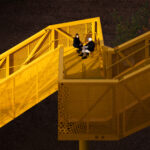In the 1910s, Eritrea — a small East African country bordering with Sudan, Ethiopia and the Red Sea — stood as the industrial center for the administrative territory of Italian East Africa. Powered by Italian Fascists who challenged architect Odoardo Cavagnari to design a “Little Rome,” the Eritrean capital Asmara became a space of experimentation for radical Italian architects. The small village saw hundreds of bold designs sprout, further influencing the vernacular architecture of the region.

St Mary’s Orthodox Cathedral © Edward Denison, 2016
Asmara experienced huge population growths throughout the 1930s, largely due to influxes of Italian immigrants and the attractiveness of its modernist architecture, which — as illustrated by the photographs of visitors like Edward Denison — appears to have been preserved as it looked when the planned city first bloomed under Fascist rule.

© Edward Dension
Cinema Impero © Edward Denison, 2016
From 1941 to 1950, Eritrea was governed by a British military administration, after which the country was federated under Ethiopia, a US-prompted decision that triggered the ensuing Eritrean War of Independence. The War went on for 30 years, until a UN-supervised referendum resolved the wish for Eritrean people to gain independence and international recognition.
In 1993, the Eritrean People’s Liberation Front (EPFL) established a one-party state, and no election has been held since. In fact, the influence of Ethiopian rule is still very powerful in Eritrea, and the drawn-up constitution was never implemented, resulting in a country with poor infrastructure and a stagnant economy.

Fiat Tagliero © Edward Denison, 2016
After decades of war and an isolated political conversation, Asmara is a reminder of planned capitals like Brasilia in Brazil and La Havana in Cuba — built with nationalism in mind — but consequently neglected due to a lack of infrastructural funds during the transition of external administrative powers.

Capri Bar © Edward Denison, 2016
Asmara is a city of deep contrasts, from a modernist architecture that has earned it the evocative nickname “the Miami of Africa” to the deep poverty facing many of its citizens. The human-rights-violating dictatorship is forcing thousands to emigrate north each month, often at the cost of many lives due to the dangers of smuggling conditions in the Mediterranean.

Bar Zilli © Edward Denison, 2016
At 7,900 feet of altitude, Asmara resembles an abandoned film set, its idle population waiting in cafés and the remains of Italian plazas. Art deco buildings align behind palm trees on large avenues and boulevards, their style reminiscent of similar colonial cities such as Rabat, Mogadishu, Tripoli and Casablanca. Nowadays, preservationists behind the Asmara Heritage Project are fighting to make the city a UNESCO World Heritage Site.
Denison, a strong advocate for this decision, explains that “it is much harder for a country like Eritrea to make these submissions, so consequently, Africa has many fewer [World Heritage] sites.” He also hopes that if this bid is successful, it can shed light on better balancing the recognition and treatment of heritage, globally.

Odeon Bar © Edward Denison, 2016
Dr. Edward Denison is an architecture expert and professor at the Bartlett School of Architecture and is the editor of a book on Asmara’s architecture.
Cover Image: Palazzo Mazzetti © Edward Denison, 2016. Images and quotes from Curbed and The Wall Street Journal









